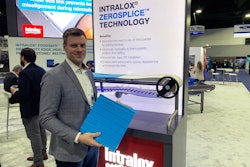
With recreational or medical-use cannabis now legalized in the majority of the U.S., the market is experiencing significant growth—expected to reach $72 billion in annual revenue by 2030, according to New Frontier Data. To keep up with projections, cannabis product manufacturers must be innovative, increase output to keep up with the escalating demand, and ensure that their products comply with ever-changing industry standards and regulations.
Demand for cannabis-infused products continues to grow and has led to the development of water-dissolvable THC powders, which offer advantages over traditional THC consumption. Water compatibility ensures optimal bioavailability, enabling rapid absorption and consistent effects. Unlike THC edibles or oil, which have to be broken down in the liver before entering the blood stream, water-dissolvable THC powders enter the bloodstream more directly and efficiently, leading to enhanced bioavailability and faster onset of effects.
The powders are created by using advanced nanoemulsion technology—stable mixtures of oil and water achieved through the reduction of oil droplets to nanoscale sizes, typically less than 100 nm. By breaking the THC oil down into such small droplets, it becomes highly dissolvable in water and forms a clear, stable emulsion that can then be made into a powder via spray drying. The powders can then be added to a wide range of products, including hot and cold beverages, smoothies, baked goods, and more.
The art and science of cannabis powders
The development of water-dissolvable THC-infused powders from a nanoemulsion requires expertise in emulsion technology, formulation science, and the selection of appropriate equipment and ingredients. Florida-based cannabis brand Le Herbe has been mastering its craft for nine years, conquering many technical issues along the way, notes Jay Grillo, founder and CEO.
Le Herbe entered the market in 2014 with cannabis-infused ready-to-drink (RTD) beverages that used nanoemulsions to create stable and bioavailable formulations. Four years later, the company recognized the need to extend its existing beverage shelf life by converting liquid to powder, developing a line of ready-to-mix (RTM) THC-infused single-serving drink powders that dissolve instantly in hot or cold liquids.
“Our cannabis powder is a collection of microparticles; they mimic the resin heads of stalked glandular trichomes,” Grillo explains. Based on the findings of Marcus “Bubble Man” Richardson, Le Herbe was able to reverse engineer the resin heads of a stalked glandular trichomes that can be found on a Cannabis sativa L. “The thin layer of wax present on the cuticle surface of the cannabis trichomes can be substituted with commercially available ingredients.”
In Le Herbe’s primary formulation, a particle shell protects the cannabinoids from oxygen, light, and crystallization. “This process allows for healthier, lighter-weight powders that have fewer ingredients, dissolve in water quickly, and have a shelf life of three years,” Grillo says.
Cannabis powders are an advancement from cannabis-based RTD beverages—an improvement over a form that loses effectiveness over time, according to Grillo. “We still make RTDs for clients, but we only produce powder because scientific data will lead you to this product format time after time. We created the product category out of necessity and quality by design principles,” he says. “Cannabis powder has a shelf life of three years and gets better with age, while cannabis beverages start to degrade rapidly over time with a shelf life between three and six months.”
On top of that, there are logistical considerations. A single serving of cannabis powder with the packaging weighs 7 g, compared with a single serving of a cannabis beverage at 340 g (12 oz). “We would much rather send 64 single servings in the mail that weighs less than a pound than one or two single servings of a cannabis beverage with similar weight,” Grillo says.
Powders at scale
Cannabis beverages are also difficult to scale because of capital, equipment, packaging, storage, and shipping requirements, Grillo notes. Cannabis powder, on the other hand, doesn’t require temperature-controlled environments, large storage facilities, or large trucks for transportation.
When it was looking to scale its production, Le Herbe’s team searched for a U.S.-based toll manufacturer that specialized in spray drying equipment. Le Herbe chose Pulse Combustion Systems (PCS), which provides spray drying equipment for various industries, including food, nutraceutical, and pharmaceutical. In the pursuit of producing water-dissolvable oil-infused powders, PCS developed the P-5, a state-of-the-art plug-and-play spray dryer that was able to achieve the final step in what is a very technical process.
 Pulse Combustion Systems has pioneered a gas-dynamic atomization method specifically designed for the efficient drying of liquid feed materials.Pulse Combustion Systems
Pulse Combustion Systems has pioneered a gas-dynamic atomization method specifically designed for the efficient drying of liquid feed materials.Pulse Combustion Systems
PCS pioneered a gas-dynamic atomization method specifically designed for the efficient drying of liquid feed materials. The technique uses a high-velocity gas stream, reaching speeds of up to 300 mph, to atomize and dry the liquid feed. The process involves two key air streams: the main process air, generated by a blower and heater, which serves as the hot air responsible for both atomization and drying; and the transportation air, which is introduced to the system to reduce humidity in the drying chamber and maintain low exit temperatures to prevent damage to sensitive products.
The liquid feed enters the top of the drying chamber in a co-current fashion through an open pipe. Prior to reaching the atomization zone, the feed product passes through a proprietary nozzle, engineered to create an optimal spray pattern. Notably, this entire process operates at low pressures, typically below 5 psi, eliminating the need for high-pressure pumps and nozzles. This approach significantly reduces maintenance costs and enables the atomization and drying of viscous and high-solids feeds that would otherwise clog conventional spray nozzles. With this technology, the liquid feed is transformed into a dry, cool powder in less than 1 second.
High-shear mixing
 The ROSS High Shear Mixer rotor-stator is used to make a coarse emulsion that can be further reduced to a nanoemulsion.ROSS Mixers
The ROSS High Shear Mixer rotor-stator is used to make a coarse emulsion that can be further reduced to a nanoemulsion.ROSS Mixers
The ROSS mixer is another key component in making Le Herbe’s cannabis powder. “A rotor-stator is required to make a coarse emulsion so you can further reduce the particle size below 100 nm by forming a nanoemulsion,” Grillo says. “ROSS’s equipment is a workhorse for these product lines and can be serviced if necessary with minimal downtime because it’s made in the USA.”
The ROSS High Shear Mixer consists of a single-stage four-blade rotor that turns at high speed within a stationary stator. As the rotating blades pass each opening in the stator, they mechanically shear particles and droplets, and expel material at high velocity into the surrounding mix, creating intense hydraulic shear. As fast as material is expelled, more is drawn into the bottom of the rotor/stator generator, which promotes continuous flow and fast mixing resulting in efficient particle size reduction, emulsification, and dispersion.
THC powders from start to finish
To produce water-dissolvable THC powders, the manufacturing process begins with the extraction of THC from cannabis plants using methods like CO2 extraction or solvent-based extraction. The extracted THC is then combined with a carrier oil, and an emulsifier or surfactant. Le Herbe uses the ROSS High Shear Rotor/Stator Mixer for emulsions and slurries.
The emulsions can be categorized as microemulsions, nanoemulsions, or macroemulsions. “The rotor-stator helps us mix maltodextrin, essential or flavor oils, and cannabinoids in a batch process with consistent results,” Grillo explains. “We usually run our rotor-stator for 5 to 30 minutes and between 1,000 and 10,000 rpm. The rotor-stator gives us a repeatable process based on time, rpm, vessel dimension, workhead, and depth of stator.”
Following the mixing process, the nanoemulsion is thoroughly analyzed. According to Jay, Le Herbe has several testing protocols to ensure they are producing the highest quality products. “Before formulation, we test for purity, microbiology, and batch-to-batch consistency,” Grillo says. “After formulation, we test with dynamic light scattering (DLS), zeta-potential, encapsulation efficiency (EE), polydispersity index (PDI), laser diffraction, bioavailability-potential, transmission electron microscopy (TEM), scanning electron microscopy (SEM), and simulated digestion (Infogest).”
After testing has been completed, the nanoemulsion is fed into the Pulse P-5 spray dryer to convert it into a powdered form. This step removes the water content, leaving behind a stable and highly dissolvable THC powder. It is then tested once again before being packaged and shipped to customers across the U.S.
“Making a nanoemulsion and then converting it to powder is not as easy as it seems, and only a few people in the world really know how to do this due to the artisan nature,” Grillo says.
Le Herbe does much of its production in-house but uses PCS’s facility to process hemp-derived cannabinoids and also for experiments, tolling, scale, and certifications, he adds.





















